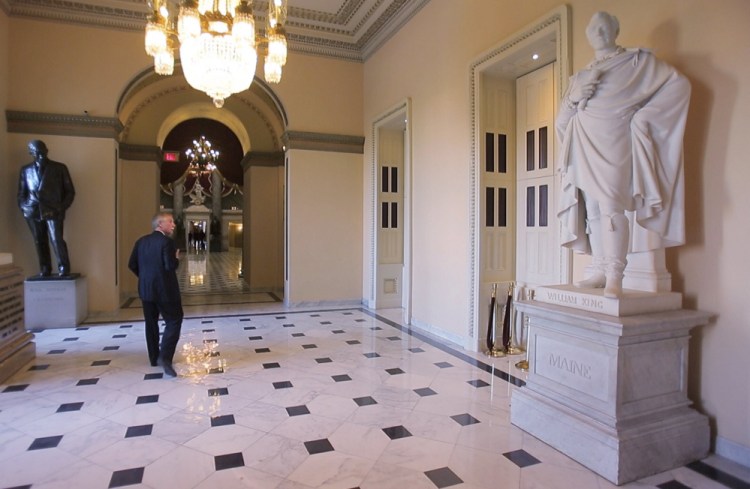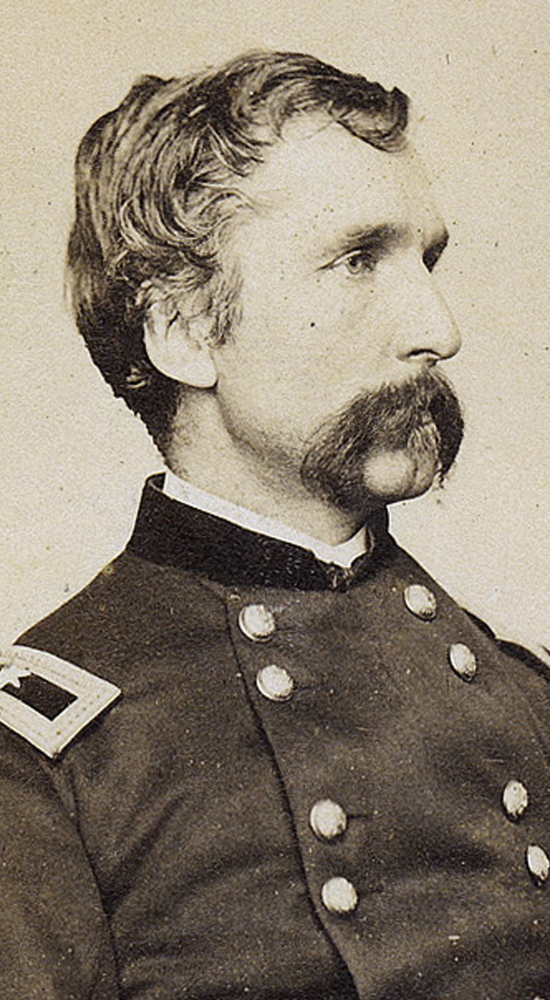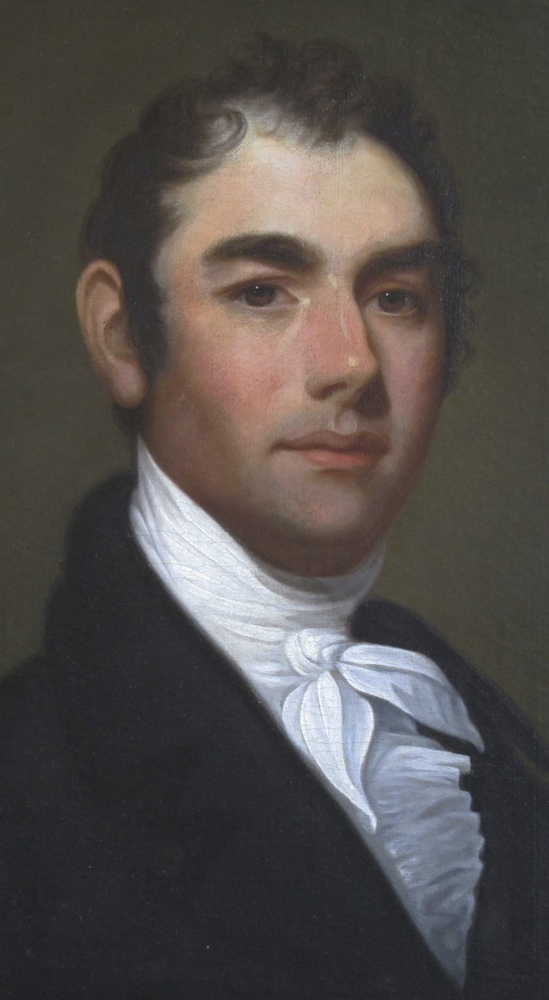Look out, Gov. William King.
Gen. Joshua Lawrence Chamberlain is gunning for your spot among the stone-faced sentries of the U.S. Capitol.
Well, not Chamberlain himself, of course, but a Maine state lawmaker who believes it is time that the Civil War hero is given the honor of representing Maine in the hallways of the nation’s Capitol.
Each state gets two spots within the ranks of statues that line National Statuary Hall and other corridors in the art-filled Capitol. Since 1878, William King has occupied one of Maine’s two spots as the man who led the effort to break away from Massachusetts in 1820 and then became the state’s first governor.
But state Sen. Garrett Mason, R-Lisbon Falls, is sponsoring legislation that would begin the process of replacing King’s statue with one of Chamberlain, who served as Maine’s 32nd governor after rising to national fame for his Civil War service.
“I just think that Joshua Chamberlain is a national hero. William King is a state hero,” Mason, who is the Senate majority leader, told members of the Legislature’s Education and Cultural Affairs Committee on Thursday.
“Anybody who has a general knowledge of the Civil War knows that without Joshua Chamberlain and the men of the 20th Maine (regiment), we may have seen the war go in a different direction,” Mason said. “William King has had 100 years in Statuary Hall. It is time for him to come home and be displayed here in our state Capitol.”
Located near the famed Capitol Rotunda, National Statuary Hall is one of the most visited sections of the Capitol. Thousands of visitors stroll the hall every day to look at the state-sponsored statues and, occasionally, to explore the unique acoustics that allow visitors to whisper to each other from across the massive, domed room.
Statuary Hall is home to 38 of the state statues, including Maine’s second contribution honoring Hannibal Hamlin, who served as vice president during Abraham Lincoln’s first term and through much of the Civil War. The remainder of the statues, including King’s, line other hallways in the Capitol.
Congress created the National Statuary Hall Collection in 1864, but in 2000 passed a law allowing states to request that the Joint Committee on the Library of Congress consider replacing statues.
At least five states have done so. California swapped an earlier statue for one depicting the late President Ronald Reagan in 2009. Alabama replaced a statue with one honoring Helen Keller.
Mason’s bill, L.D. 261, would create an 11-member commission to select a sculptor for the Chamberlain statue, raise money for the project and represent the state in its petition to the Library of Congress. All costs for the statue swap – with the exception of about $2,500 in state funds to cover commission expenses – would come from private donations, Mason said.
‘FRIENDLY COMPROMISE’ OFFERED
It was unclear Thursday how much it would cost to commission, build and install a Chamberlain statue as well as transport the King statue back to Maine.
The National Endowment for the Arts awarded a $250,000 prize to the winner of a design competition for a bronze statue memorializing the Civil Rights icon Rosa Parks that was commissioned by Congress and installed in National Statuary Hall in February 2013. The Keller statue installed by Alabama in 2009 was estimated to cost about $325,000, according to news reports at the time.
Mason touted his proposal as a way to both honor Chamberlain with his first statue outside of Maine and elevate King’s stature back home in time for the state’s 150th anniversary in 2020. But Rep. Jennifer DeChant, a Democrat who represents King’s adopted hometown of Bath, made the case to keep Maine’s first governor in Washington.
DeChant insisted she was not testifying against Chamberlain, which she said would be “like testifying against Santa Claus” in Maine. But she offered a “friendly compromise” of bringing Hamlin’s statue home to Maine, because there is already a bust of him in the Capitol’s collection of vice presidential busts, and keeping King in Washington in recognition of the role he played in the state’s creation.
“As a representative of the City of Bath, we are extremely proud of the fact that the one statue that exists of our son of Bath and the first governor of Maine exists in the federal Capitol,” DeChant said.
Born in what was then Scarborough, Massachusetts, in 1768, King rose to become one of the area’s most successful early entrepreneurs. He was Maine’s largest ship owner, was a principal in the state’s first cotton gin mill in Brunswick and represented the Topsham/Bath area in the Massachusetts General Court. He spent seven years working to secure statehood for Maine and served one year as the state’s first governor as a Democratic-Republican, which was the Republican party created by Thomas Jefferson. He died in 1852 and is buried in Bath.
CHAMBERLAIN’S CONTRIBUTION
Chamberlain was a Bowdoin College professor when he requested a commission as officer in the Union Army during the Civil War. The young colonel helped lead the 20th Maine Regiment through several battles, but rose to fame at the Battle of Gettysburg when, undermanned and running low on ammunition, he ordered his troops to fix bayonets and charge Confederate forces on Little Round Top.
The strategy worked and thwarted Confederate attempts to flank the Union lines on the second day of fighting at Gettysburg, which is often described as the turning point of the Civil War. Chamberlain would later be awarded the Medal of Honor for his leadership on Little Round Top.
Promoted to brigadier general by the end of the war, Chamberlain was selected to play a prominent role in Confederate Gen. Robert E. Lee’s formal surrender at Appomattox, Virginia, in 1865. He later served four years as Maine’s governor and as president of Bowdoin College.
Chamberlain historian and author Tom Desjardin noted that there are no statues of the general outside of Maine, despite his fame among Civil War buffs. Desjardin, who is Maine’s education commissioner but testified Thursday on his own behalf, took no official position on the swap proposal but said the state could honor King by putting his statue on display in the Hall of Flags in the State House.
“As to the replacement, I think it would be fitting for Maine to be represented by the tremendous example set by a man who began his life as a stuttering, shy and introverted youngster in Brewer in the mid-1800s who overcame poor health, insecurities and other limitations to become a world-renown soldier, statesman and academician,” Desjardin said.
Send questions/comments to the editors.






Comments are no longer available on this story